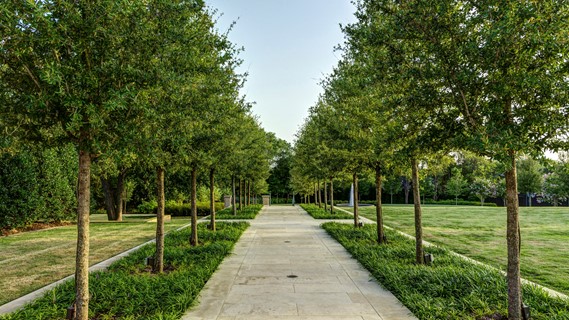Not known Incorrect Statements About Hilton Head Landscapes
Hilton Head Landscapes - Truths
Table of ContentsHilton Head Landscapes for Beginners3 Easy Facts About Hilton Head Landscapes ExplainedThe smart Trick of Hilton Head Landscapes That Nobody is DiscussingWhat Does Hilton Head Landscapes Do?Some Of Hilton Head LandscapesHilton Head Landscapes Fundamentals ExplainedHilton Head Landscapes Things To Know Before You Get This
Line develops all forms and patterns and can be made use of in a range of ways in the landscape. Line in the landscape is developed by the edge between 2 materials, the summary or silhouette of a form, or a long direct attribute. Lines are an effective tool for the designer due to the fact that they can be made use of to produce an unlimited selection of forms and types, and they control activity of the eye and the body.

Lines can have several characteristics, such as those defined below, however they generally offer different purposes. Number 1. Lines in the landscape - hilton head landscapers. The residential or commercial properties of lines establish exactly how individuals react to the landscape, both psychologically and literally. Straight lines are structural and forceful; they develop a formal personality, are usually connected with a symmetrical style, and lead the eye straight to a focal point.
Hilton Head Landscapes - An Overview
Bent lines develop a casual, all-natural, relaxed personality that is linked more with nature and unbalanced equilibrium. Bent lines relocate the eye at a slower speed and add enigma to the area by producing covert views.
Vertical lines in the landscape include high, slim plant product, such as trees, or tall structures, such as an arbor or a bird house on a post. Straight lines move the eye along the ground airplane and can make a space really feel bigger. Reduced lines are extra restrained and develop a feeling of rest or repose.
Hilton Head Landscapes Things To Know Before You Buy
Low lines are developed by low yard walls, sidewalks, and short bushes. Lines are utilized to attract forms on a strategy. In plan view, they specify plant beds and hardscape locations. Lines are likewise developed by the vertical kinds of built attributes and plant material. There are 3 main line types that develop form in the landscape: bedlines, hardscape lines, and plant lines.
Bedlines attach plant material to your house and hardscape because the eye complies with the line, moving the stare through the landscape. Hardscape lines are developed by the side of the hardscape, which defines the constructed structure. Line can additionally be created by long and slim products, such as a fencing or wall.
Hilton Head Landscapes Fundamentals Explained
Form is discovered in both hardscape and plants, and it is typically the dominant aesthetic component that spatially arranges the landscape and often determines the style of the garden. The form of frameworks, plant beds, and yard accessories likewise figures out the general type theme of the garden. Official, geometric kinds consist of circles, squares, and polygons.
Plants develop type in the yard with their describes or silhouettes, however type can likewise be defined by a space or unfavorable area in between plants - hilton head landscapers (https://packersmovers.activeboard.com/t67151553/how-to-connect-canon-mg3620-printer-to-computer/?ts=1719958014&direction=prev&page=last#lastPostAnchor). Circles can be full circles, or they can be divided into fifty percent circles or circle sections and incorporated with lines to produce arcs and tangents
Examine This Report about Hilton Head Landscapes
Circles can also be extended into ovals and ellipses for even more variety and passion. Circles are a strong layout type due to the fact that the eye is always attracted to the center, which can be made use of to highlight a focal factor or attach other kinds. Figure 2. Round forms in hardscape and grass panels.
The square kind can additionally be segmented and used repetitively to produce a grid pattern. Unlike circles, squares are more powerful on the edges, which can be lined up or overlapped to develop one-of-a-kind patterns and more complicated forms. Polygons are many-sided kinds with straight sides. Triangulars, for instance, are three-sided polygons.
Meandering lines commonly mimic the natural program of rivers or streams and can be called smooth lines with deeply rounded wavinesses. Twisting lines (Number 3) function well for paths, plant bedlines, and dry stream beds. Meandering lines can add rate of interest and enigma to a yard by leading viewers around corners to discover new views and spaces.
Rumored Buzz on Hilton Head Landscapes

Number 5. Fragmented sides: stepping rocks in path. Form is one of the most long-lasting top quality of a plant (bluffton landscaping). https://www.domestika.org/en/stevenagonzales. Typical plant kinds are well developed and standard, as form advice is the most consistent and identifiable attribute of plants. Form can also be produced with the massing of plants, where the overall mass creates a various kind than a private plant.
A highly contrasting type should be utilized with careone or more work well as a focal factor, yet way too many wreak havoc. All-natural plant types, instead of over-trimmed forms, should establish the mass of the structure. The relevance of total form is essentially dependent on the watching perspectivethe kind of a tree can appear quite various to a person standing under the cover versus viewing the tree from a range in an open field.
Hilton Head Landscapes Things To Know Before You Buy
Plant kinds additionally produce and define deep space or open areas in between the plants, producing either convex or scooped kinds in the spaces. High-arching tree branches typically create a concave open space under the branches, and a round canopy with reduced branches fills up the space to produce a convex type outdoors space under the tree.
